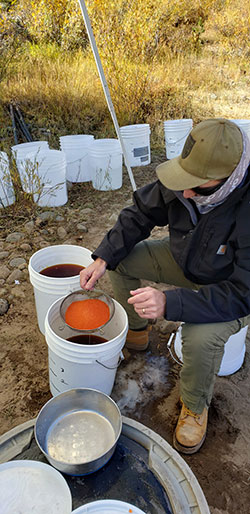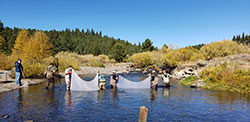In spite of challenges presented by wildfires, forest closures, unhealthy air quality and the COVID-19 pandemic, CDFW staff from the American River Trout Hatchery and Fisheries Branch nonetheless conducted four successful kokanee salmon egg collections on the Little Truckee River this fall.
CDFW biologists and hatchery staff overcame several obstacles for a successful 2020 kokanee salmon egg collection effort on the Little Truckee River.

Kokanee salmon eggs are collected and fertilized streamside, as shown in this 2019 photo, before being taken to a CDFW hatchery for incubation.

A temporary weir is set up along the Little Truckee River to block, catch and spawn kokanee salmon that have migrated up from Stampede Reservoir as shown in this 2019 photo. Among other challenges in 2020, CDFW staff had to conduct the annual kokanee spawn without the help of volunteers due to COVID-19-related precautions.
In spite of challenges presented by wildfires, forest closures, unhealthy air quality and the COVID-19 pandemic, CDFW staff from the American River Trout Hatchery and Fisheries Branch nonetheless conducted four successful kokanee salmon egg collections on the Little Truckee River this fall.
Slightly more than 1.3 million eggs were collected from kokanee salmon migrating from Stampede Reservoir in Nevada County into the Little Truckee River to spawn. Stampede Reservoir’s kokanee salmon serve as CDFW’s broodstock for the popular State fishery.
CDFW typically relies on volunteers from the public and angling groups to help with the annual egg collection effort – but that extra manpower was unavailable this year due to COVID-19 precautions.
“This year was unique to say the least, but this was a high priority for us,” said Jason Julienne, senior environmental scientist supervisor for CDFW’s North Central Region hatcheries. “Many of the waters that support the kokanee fishery are not self-sustaining, and depend on annual releases to provide ample opportunity for anglers.”
Due to COVID-19 concerns, this year’s egg collection involved less staff than normal, which slowed the process a bit. Typically, the team can collect all the eggs needed to support the program in two to three days. This year, it took four days, and required extensive coordination with the U.S. Forest Service in order to get special access to closed areas of the Tahoe National Forest.
“Luckily, everything came together on time and we were able to get it done,” Julienne said. “We had 12 to 15 staff participating in each of the four egg collections, as well as two staffers who remained onsite for five weeks to maintain the fish barrier weir and monitor salmon numbers coming up the river.”
The collected eggs are now being incubated at CDFW’s San Joaquin Hatchery and American River Trout Hatchery. Once the fry reach about three inches in size, they will be stocked to support recreational fishing at 15 lakes and reservoirs throughout the state. About 850,000 kokanee fry are released annually.
Kokanee salmon (Oncorhynchus nerka) are the landlocked version of Sockeye salmon native to Alaska and the Pacific Northwest. Instead of migrating to the ocean, adult kokanee inhabit large lakes and impoundments before returning to their natal streams or using gravel shorelines to spawn. Like all Pacific salmon, kokanee die after spawning, their whole life cycle spanning two to four years.
Although they only average about 12 inches in size as adults, kokanee salmon are an exceptionally popular sport fish noted for their excellent table fare. As the kokanee fishery has thrived, bag and possession limits have been increased at several lakes and reservoirs in recent years, including at Lake Pardee in Amador County, New Bullard’s Bar Reservoir in Yuba County and Trinity Lake in Trinity County.
###
Media Contact:
Peter Tira, CDFW Communications, (916) 215-3858
CDFW Photos